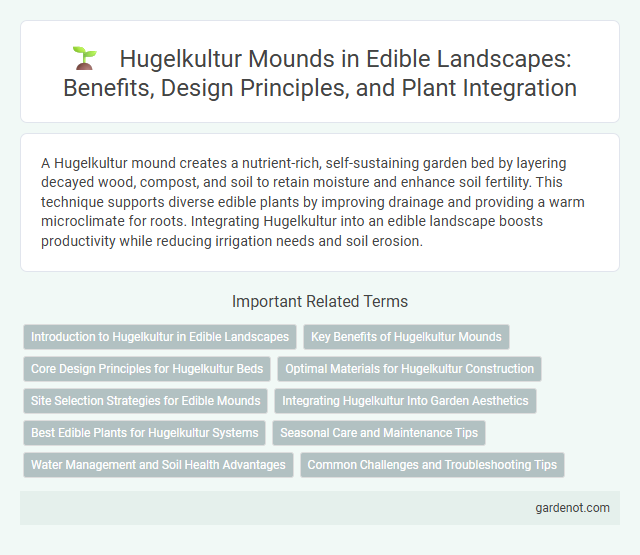A Hugelkultur mound creates a nutrient-rich, self-sustaining garden bed by layering decayed wood, compost, and soil to retain moisture and enhance soil fertility. This technique supports diverse edible plants by improving drainage and providing a warm microclimate for roots. Integrating Hugelkultur into an edible landscape boosts productivity while reducing irrigation needs and soil erosion.
Introduction to Hugelkultur in Edible Landscapes
Hugelkultur is an ancient gardening technique that involves creating raised mounds by layering decomposing wood, organic matter, and soil, enhancing moisture retention and nutrient availability. These mounds promote soil fertility and support diverse edible plants in sustainable landscapes by improving aeration and microbial activity. Integrating Hugelkultur into edible landscapes offers a low-maintenance method to boost productivity and resilience in food gardens.
Key Benefits of Hugelkultur Mounds
Hugelkultur mounds enhance soil fertility by decomposing wood and organic matter, which enriches nutrient availability for plants. They improve water retention and drainage, reducing irrigation needs and preventing soil erosion. These mounds create microclimates that extend growing seasons and support diverse edible plant varieties within edible landscapes.
Core Design Principles for Hugelkultur Beds
Hugelkultur beds rely on key design principles including layering of organic materials such as logs, branches, leaves, and compost to promote soil fertility and moisture retention. The core structure incorporates a central wood core that slowly decomposes, enriching the soil and enhancing microbial activity while providing natural irrigation. These mounds are typically raised to improve drainage and airflow, creating an optimal environment for diverse edible plants and maximizing garden productivity.
Optimal Materials for Hugelkultur Construction
Optimal materials for Hugelkultur construction include a balanced combination of hardwood logs, branches, and twigs which provide long-term nutrient release and structural support. Layering decomposable organic matter such as leaves, grass clippings, and kitchen scraps enhances soil fertility and water retention. Avoid softwoods treated with chemicals or pine needles to prevent acidity and toxicity in the mound.
Site Selection Strategies for Edible Mounds
Site selection for Hugelkultur edible mounds requires well-drained, sunny locations with access to organic matter such as decomposing wood, branches, and leaves to enhance soil fertility and moisture retention. Avoiding low-lying areas prone to waterlogging reduces root rot and maximizes aeration, ensuring optimal plant growth. Proximity to water sources and integration with existing garden beds supports sustainable irrigation and nutrient cycling in edible landscapes.
Integrating Hugelkultur Into Garden Aesthetics
Hugelkultur mounds enhance edible landscapes by combining soil enrichment with visual appeal, using decomposing wood layers to retain moisture and improve fertility. Integrating these mounds into garden aesthetics involves designing curved, naturalistic shapes that blend with surrounding plants and pathways, creating a harmonious, productive environment. The elevated structure supports diverse crops, offering varied textures and heights that enrich both the garden's visual interest and ecological function.
Best Edible Plants for Hugelkultur Systems
Hugelkultur mounds thrive with nutrient-rich, moisture-retentive soil ideal for deep-rooted perennials such as asparagus, rhubarb, and artichokes. Nutrient-demanding annuals like tomatoes, peppers, and squash perform exceptionally well when planted near decomposing wood layers that release essential minerals. Shade-tolerant herbs including mint and chives adapt to varied light conditions on Hugelkultur systems, enhancing biodiversity and yield.
Seasonal Care and Maintenance Tips
Seasonal care for Hugelkultur mounds involves regular monitoring of moisture levels, especially during dry summer months, to maintain soil hydration and support plant growth. In spring, adding organic mulch and compost replenishes nutrients, while pruning and removing dead plant material in late fall helps prevent disease and promotes healthy decomposition. Winter protection, such as insulating with straw or leaves, safeguards the mound's microbial activity and root systems against freezing temperatures.
Water Management and Soil Health Advantages
Hugelkultur mounds enhance water retention by capturing and slowly releasing moisture through decomposing wood layers, reducing irrigation needs in edible landscapes. The rich organic matter within the mound improves soil structure, aeration, and nutrient availability, promoting robust plant growth. This technique also supports beneficial microbial activity, which boosts soil fertility and overall ecosystem health.
Common Challenges and Troubleshooting Tips
Hugelkultur mounds often face challenges such as uneven decomposition rates and moisture retention issues, leading to inconsistent plant growth. To troubleshoot, use a well-balanced mix of fresh and decomposed wood, ensuring deeper layers promote long-term nutrient release while surface layers retain moisture effectively. Regularly monitor soil moisture and add mulch to prevent drying, fostering a thriving edible landscape.
Hügelkultur mound Infographic

 gardenot.com
gardenot.com